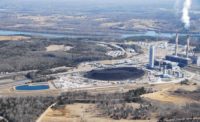Despite President Donald Trump’s best efforts to bring back coal miners’ jobs, coal-fired power plants in the United States have continued their long march to retirement. If that trend, driven by many factors, continues as expected, retirement will culminate in a demolition derby. Sadly, the decline in coal demand will mean the continued loss of miners’ jobs, but for engineers and contractors, the boom times may be just beginning.
For many years until the mid-aughts, coal-plant generation served an average of roughly 50% of total U.S. electricity demand, while natural gas fueled 17% to 20%. Since 2008, however, of the utility-scale power plants retired in the U.S. that used fossil fuels, 47% were powered by coal, according to data from the U.S. Energy Information Administration. As a result, the share of total electricity supplied by coal-fired power plants in 2017 was 30% and falling; natural gas’s share was 32% and rising.
Environmental concerns and regulations played a role in coal’s decline, but economics was decisive: the average cost of natural gas delivered to generators in 2018 is forecast to fall 2%, EIA says, while the delivered cost of coal is forecast to rise 5%.
Simply put, cheap natural gas from shale is outcompeting coal on both economic and environmental grounds. Coal-fired power plants are rapidly losing favor. Prudent business practice requires that uncompetitive plants be shut down, decommissioned and demolished.
What comes next
Duke Energy now is engaged in a complex, multiyear process of decommissioning and demolishing coal-fired power plants (D&D). Calling the economics of coal “really challenged,” CEO Lynn Good says Duke’s “strategy will continue to be to drive carbon out of our business.” As a giant utility largely fueled by coal, Duke provides a good example of what is happening in the U.S.
Half of the utility’s generating fleet in the Carolinas has been retired, including the entire coal fleet in eastern North Carolina, says Jeff Brooks, Duke spokesman. Following D&D, the sites of retired coal plants must be remediated and restored to recycle their valuable real estate. The plants’ generating capacity must be replaced and in some cases expanded.
Since 2011, Duke has retired 17 coal plants with total capacity of 5,424 MW and plans to retire four more totaling 2,006 MW by 2024. D&D costs “typically range from $10 million to $40 million per site,” Brooks says. Over a 13-year period, that has cost “several hundred-million dollars. Also, we’ve spent around $11 billion for new natural gas and solar generation across our service area,” he adds.
As with constructing and commissioning a new plant, D&D requires extensive contractor services to shut system connections, clean up and remediate materials, remove structures, bring down the retired plant and restore the site. Black & Veatch is providing services for both ends of the plant life-cycle. “Natural gas, renewables and microgrids continue to be integral to generation portfolios,” a spokesman says, and the contractor is meeting demand for those facilities. “We are also seeing more and more power delivery work as clients integrate renewables into the grid, and the capital expenditure plans for utilities indicates power delivery will be a major area of focus through 2019.”
President Trump rode into office promising to protect American jobs, but he missed his guess on which ones he could protect. The coal miner’s lament is being drowned out by the demolition contractor’s, solar installer’s and electrician’s work song.
Thomas F. Armistead is the editor of ENR Energy.




Post a comment to this article
Report Abusive Comment